engine CHEVROLET ASTRO 1998 2.G Repair Manual
[x] Cancel search | Manufacturer: CHEVROLET, Model Year: 1998, Model line: ASTRO, Model: CHEVROLET ASTRO 1998 2.GPages: 414, PDF Size: 21.46 MB
Page 61 of 414
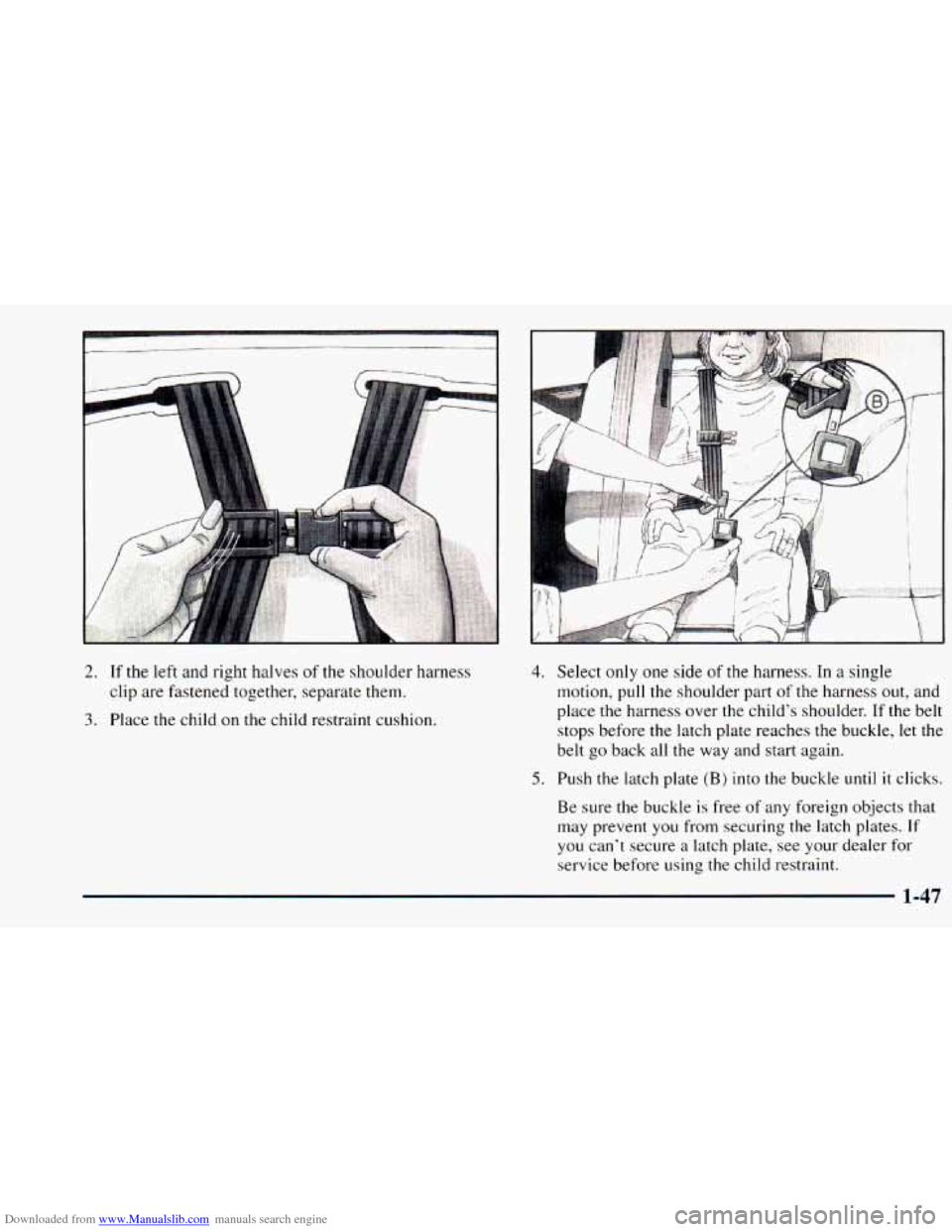
Downloaded from www.Manualslib.com manuals search engine 2. If the left and right halves of the shoulder harness
clip are fastened together, separate them.
3. Place the child on the child restraint cushion.
4. Select only one side of the harness. In a single
motion, pull the shoulder part
of the harness out, and
place
the harness over the child's shoulder. If the belt
stops before
the latch plate reaches the buckle, let the
belt go back all the way and start again.
5. Push the latch plate (B) into the buckle until it clicks.
Be sure the buckle
is free of any foreign objects that
may prevent you from securing the latch plates.
If
you can't secure a latch plate, see your dealer for
service before using the child restraint.
1-47
Page 62 of 414
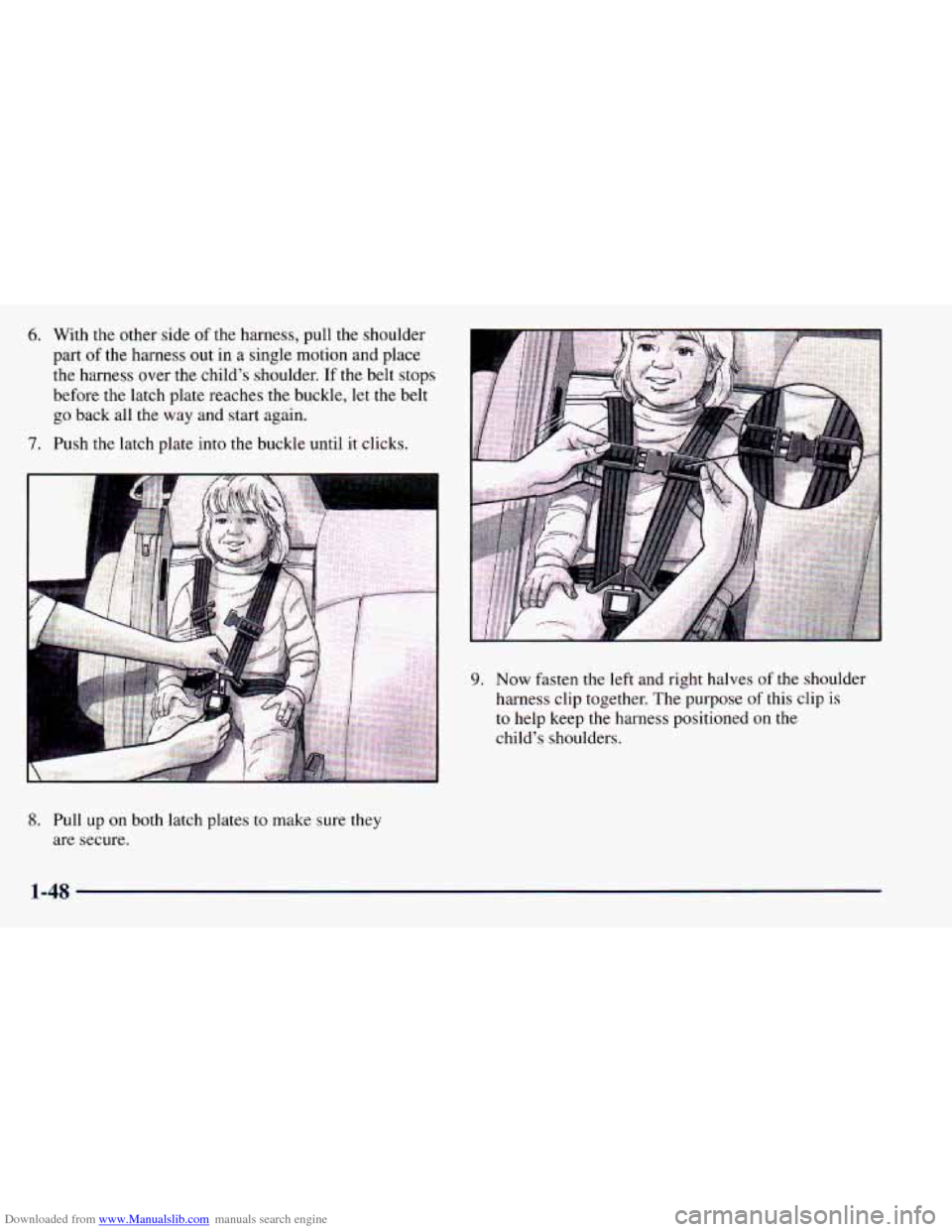
Downloaded from www.Manualslib.com manuals search engine 6. With the other side of the harness, pull the shoulder
part
of the harness out in a single motion and place
the harness over the child's shoulder.
If the belt stops
before the latch plate reaches the buckle, let the belt
go back all the way and start again.
7. Push the latch plate into the buckle until it clicks.
8. Pull up on both latch plates to make sure they
are secure.
9. Now fasten the left and right halves of the shoulder
harness clip together. The purpose
of this clip is
to help keep the harness positioned on the
child's shoulders.
1-48
Page 63 of 414
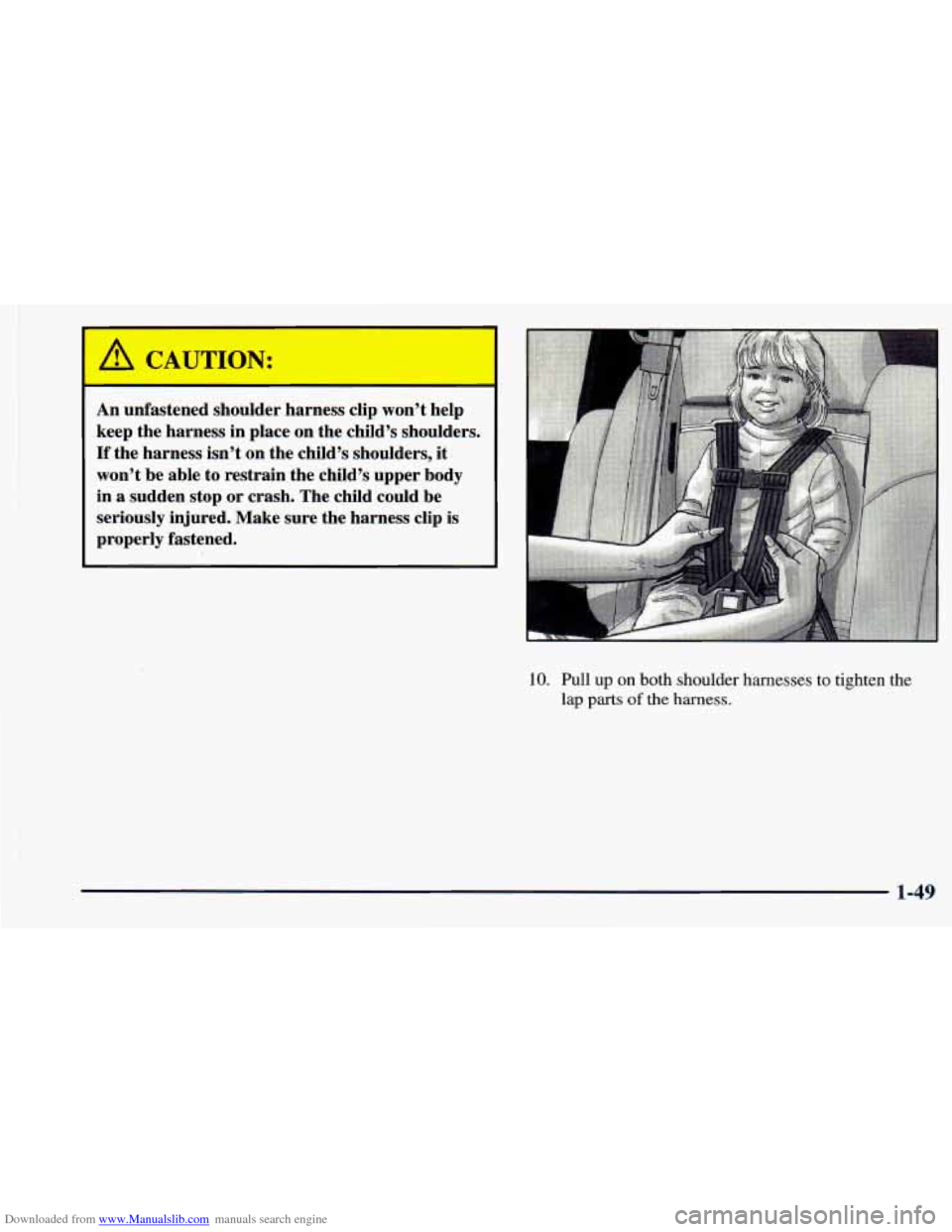
Downloaded from www.Manualslib.com manuals search engine A CAUTION:
An unfastened shoulder harness clip won’t help
keep the harness in place on the child’s shoulders.
If the harness isn’t on the child’s shoulders, it
won’t be able to restrain the child’s upper body
in a sudden stop or crash. The child could be
seriously injured. Make sure the harness clip is
properly fastened.
10. Pull up on both shoulder harnesses to tighten the
lap parts of the harness.
1-49
Page 64 of 414
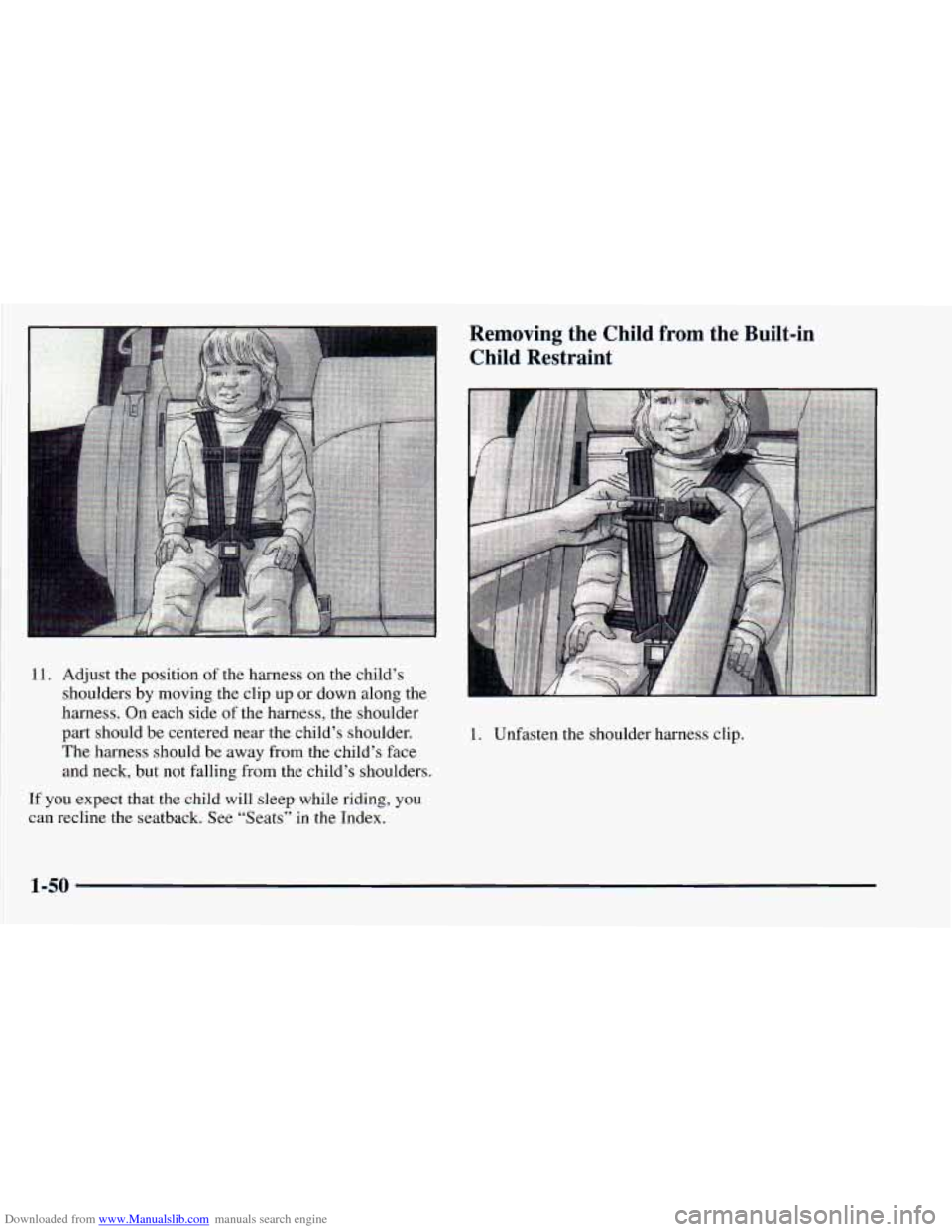
Downloaded from www.Manualslib.com manuals search engine Removing the Child trom the Built-in Child Restraint
11. Adjust the position of the harness on the child’s
shoulders by moving the clip up or down along the
harness. On each side
of the harness, the shoulder
part should be centered near the child’s shoulder.
The harness should be away from the child’s face
and neck, but not falling from the child’s shoulders.
If you expect that the child will sleep while riding, you
can recline the seatback. See “Seats” in the Index.
1. Unfasten the shoulder harness clip.
1-50
Page 65 of 414
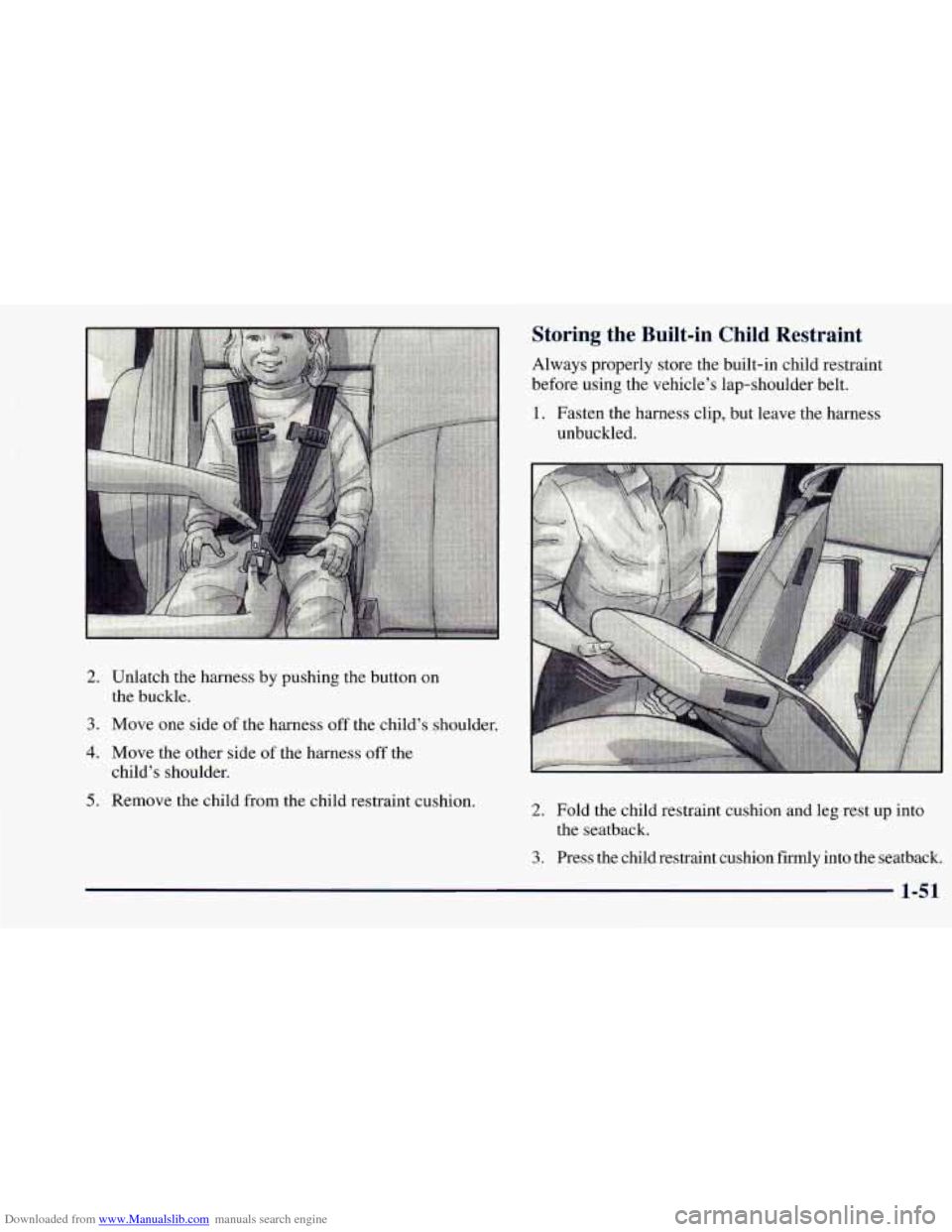
Downloaded from www.Manualslib.com manuals search engine 2. Unlatch the harness by pushing the button on
the buckle.
3. Move one side of the harness off the child's shoulder.
4. Move the other side of the harness off the
child's shoulder.
5. Remove the child from the child restraint cushion.
Storing the Built-in Child Restraint
Always properly store the built-in child restraint
before using the vehicle's lap-shoulder belt.
1. Fasten the harness clip, but leave the harness
unbuckled.
2. Fold the child restraint cushion and leg rest up into
the seatback.
3. Press the child restraint cushion firmly into the seatback.
Page 66 of 414
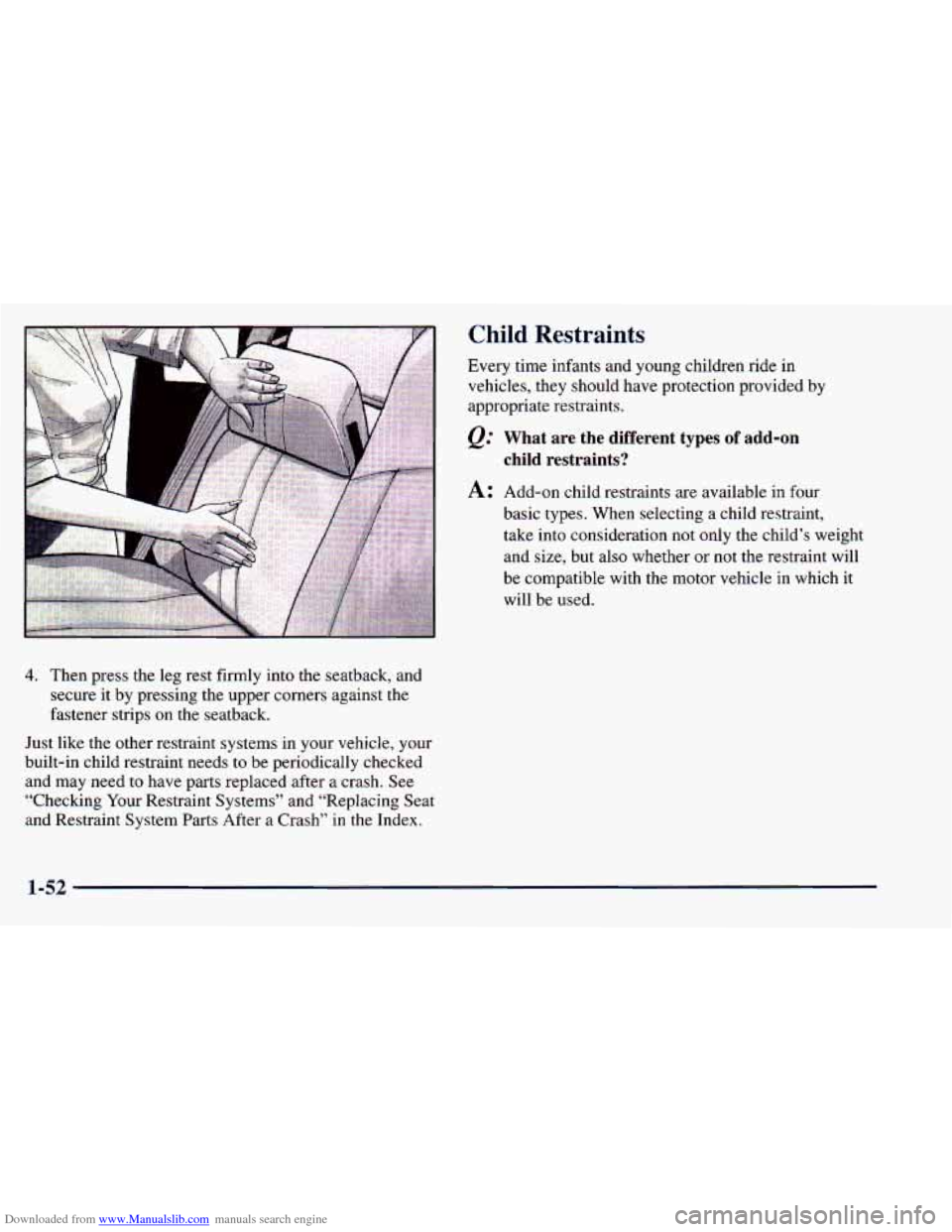
Downloaded from www.Manualslib.com manuals search engine 4. Then press the leg rest firmly into the seatback, and secure it by pressing the upper corners against the
fastener strips on the seatback.
Just like the other restraint systems in your vehicle, your
built-in child restraint needs to be periodically checked
and may need to have parts replaced after
a crash. See
“Checking Your Restraint Systems” and “Replacing Seat
and Restraint System
Parts After a Crash” in the Index.
Child Restraints
Every time infants and young children ride in
vehicles, they should have protection provided by
appropriate restraints.
@ What are the different types of add-on
A: Add-on child restraints are available in four
basic types. When selecting a child restraint,
take into consideration not only the child’s weight
and size, but also whether or not the restraint will
be compatible with the motor vehicle in which it
will be used.
child restraints?
1-52
Page 67 of 414
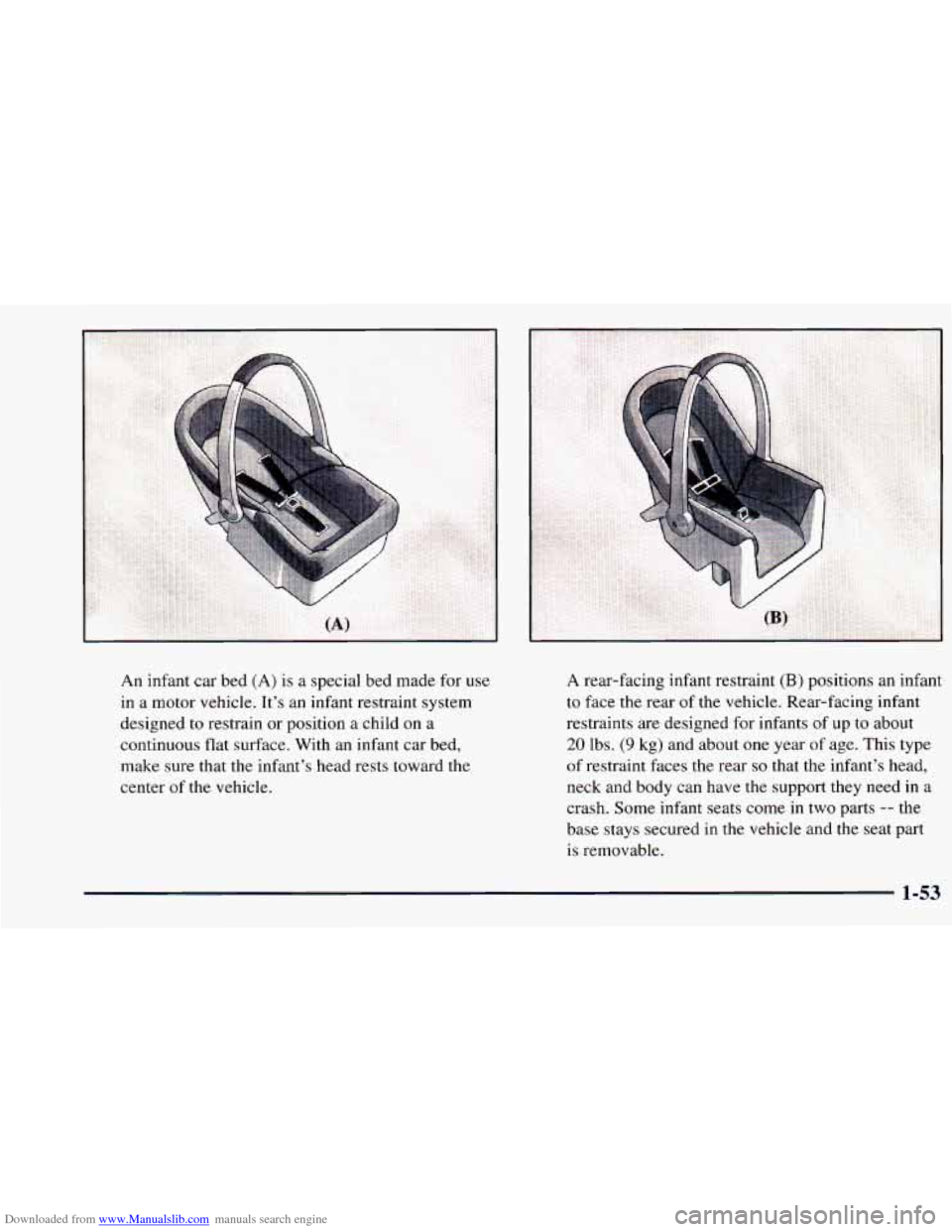
Downloaded from www.Manualslib.com manuals search engine An infant car bed (A) is a special bed made for use
in a motor vehicle. It’s an infant restraint system
designed
to restrain or position a child on a
continuous flat surface. With an infant car bed,
make sure that the infant’s head rests toward the
center of the vehicle. A
rear-facing infant restraint
(B) positions an infant
to face the rear of the vehicle. Rear-facing infant
restraints are designed for infants of up
to about
20 lbs. (9 kg) and about one year of age. This type
of restraint faces the rear so that the infant’s head,
neck and body can have the support they need in a
crash. Some infant seats come in two parts
-- the
base stays secured in the vehicle and the seat part
is removable.
1-53
Page 68 of 414
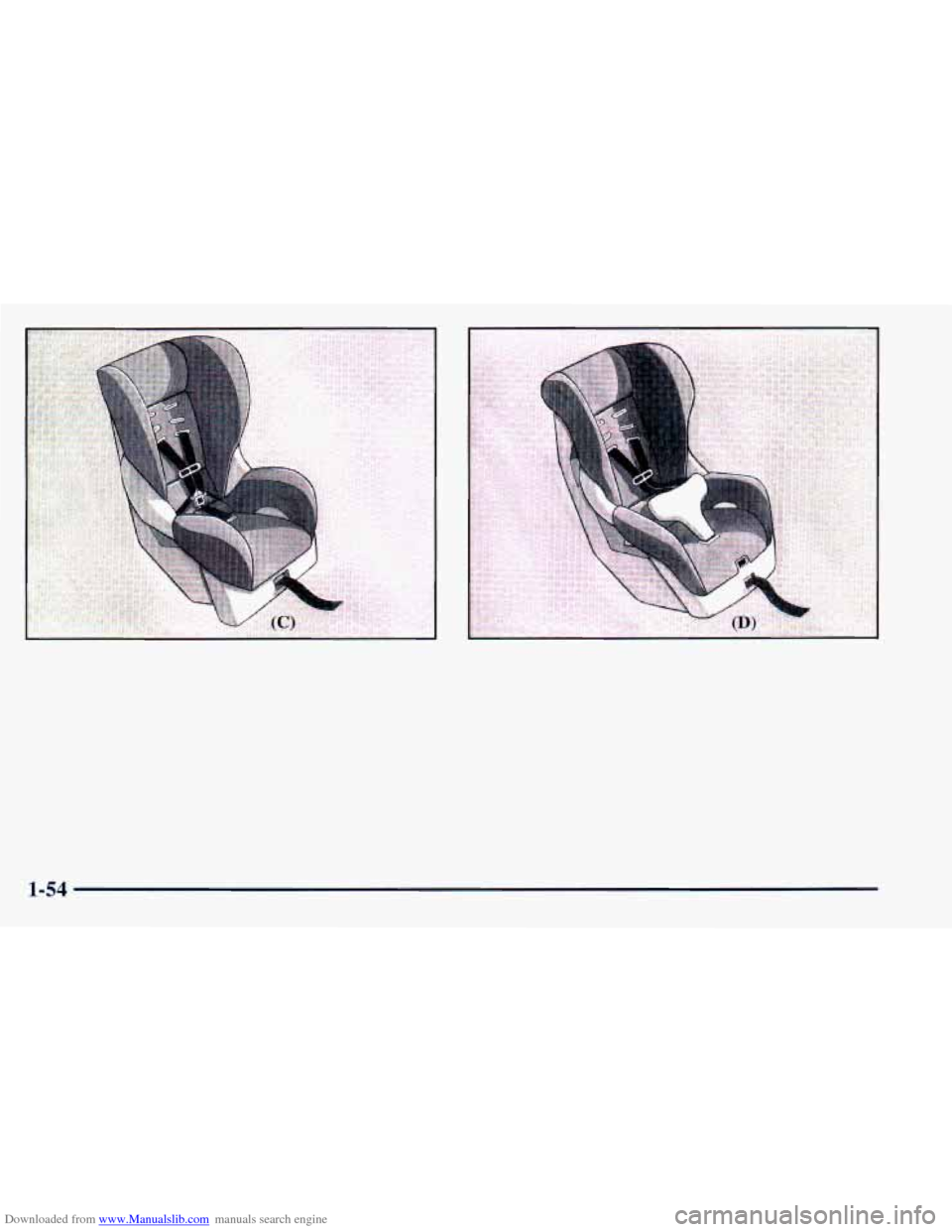
Downloaded from www.Manualslib.com manuals search engine 1-54
Page 69 of 414
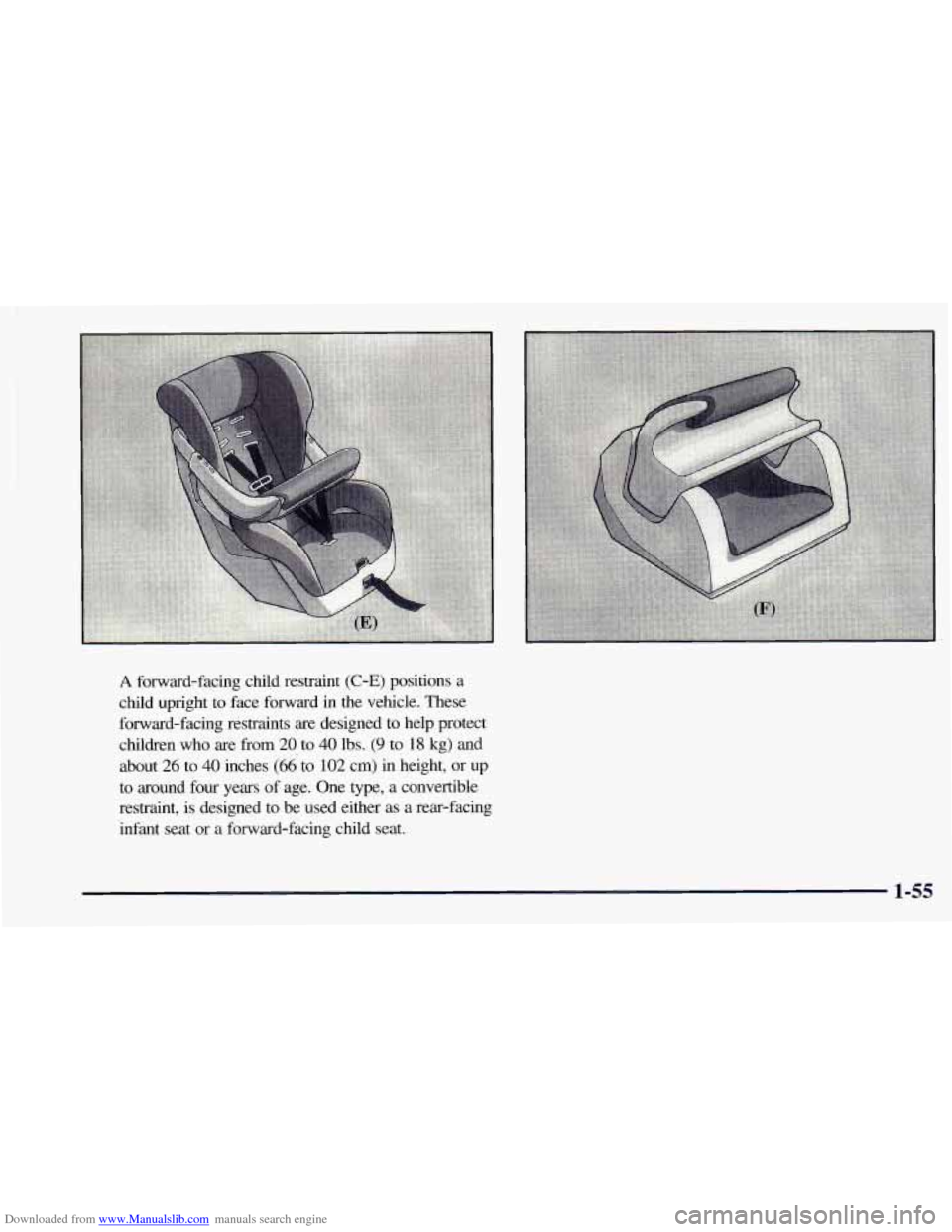
Downloaded from www.Manualslib.com manuals search engine A forward-facing child restraint (C-E) positions a
child upright to face forward in the vehicle. These
forward-facing restraints are designed to help protect
children who are from
20 to 40 lbs. (9 to 18 kg) and
about
26 to 40 inches (66 to 102 cm) in height, or up
to around
four years of age. One type, a convertible
restraint, is designed to be used either as a rear-facing
infant seat or a forward-facing child seat.
1-55
Page 70 of 414
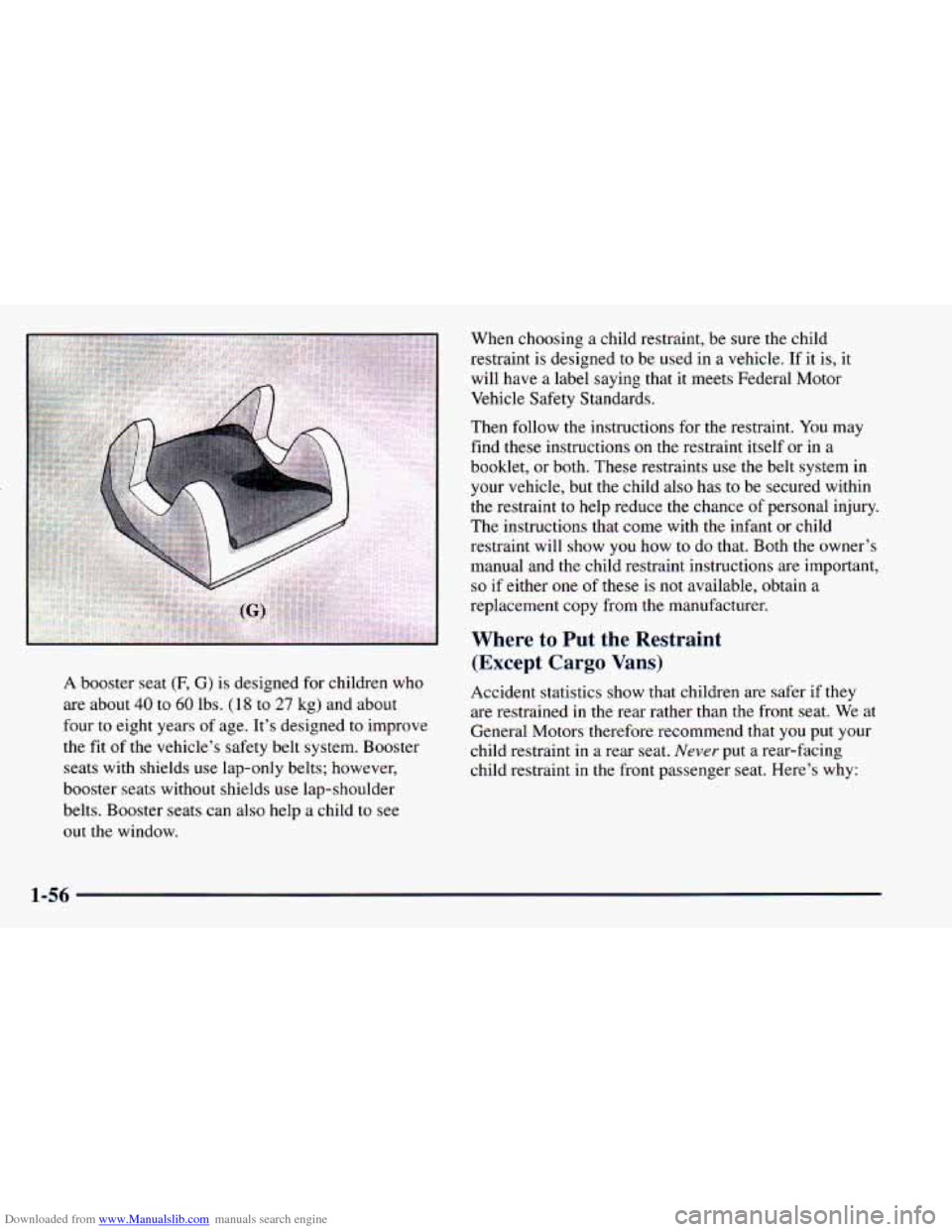
Downloaded from www.Manualslib.com manuals search engine A booster seat (F, G) is designed for children who
are about
40 to 60 lbs. (18 to 27 kg) and about
four
to eight years of age. It’s designed to improve
the fit
of the vehicle’s safety belt system. Booster
seats with shields use lap-only belts; however,
booster seats without shields use lap-shoulder
belts. Booster seats can also help a child to see
out the window. When choosing
a child restraint, be sure the child
restraint
is designed to be used in a vehicle. If it is, it
will have a label saying that it meets Federal Motor
Vehicle Safety Standards.
Then follow the instructions
for the restraint. You may
find these instructions on the restraint itself or in a
booklet,
or both. These restraints use the belt system in
your vehicle, but the child also has to be secured within
the restraint
to help reduce the chance of personal injury.
The instructions that come with the infant or child
restraint will show you how to do that. Both the owner’s
manual and the child restraint instructions are important,
so if either one of these is not available, obtain a
replacement copy from the manufacturer.
Where to Put the Restraint
(Except Cargo Vans)
Accident statistics show that children are safer if they
are restrained in the rear rather than the front seat. We at
General Motors therefore recommend that
you put your
child restraint in a rear seat.
Never put a rear-facing
child restraint in the front passenger seat. Here’s why:
1-56